|
Feline Pregnancy Signs and Symptoms (Cat Pregnancy Signs).
If you noticed your cat showing signs of being "in heat" or "in-season" just before (1-2 months before) she became fat and "pregnant looking," then there is every chance that your cat could truly be pregnant. To see pictures and photos of a cat in heat (a cat exhibiting feline estrus signs), please visit our female cat in heat page. As is mentioned in our feline heat page (above link), not all female cats will show obvious signs of being "in season" (in heat) in the presence of their owners. Likewise, not all pet owners are skilled in detecting the symptoms of cat heat behavior, even if the female cat in question is very obvious about her receptive intentions. Pet owners may, therefore, miss their female cat's heat signs altogether. Such pet owners may, however, get a clue as to their female cat's sexual receptivity and "in-heat status" by observing the behavior of male cats in the local vicinity. Male cats are expert at detecting the scent of a female cat in heat even if we ourselves, as pet owners, can not yet detect the signs. A female cat in heat will attract male cats to her, in the hope of copulation. If you noticed a number of male cats lurking around your house or garden just before (1-2 months before) your female cat became fat and "pregnant looking" then there is every chance that your female cat could truly be pregnant. Sometimes cat owners will chance upon seeing their female cat copulating with a male cat in the house or yard. The cat owner may arrive just in time to spot the mating itself (the brief seconds of male cat mounting and thrusting, whilst the female cat poses on her chest and belly beneath him), but, generally, most cat owners will only see and/or hear the after effect of the mating - when the female cat screams and attacks the male cat as he withdraws from copulation. This scream and attack will often be very short-lived, after which the female cat will roll on her back affectionately (termed a post-coital or post-copulatory roll). If your female cat is observed to yowl and attack a male cat (generally a larger bodied cat), particularly if this attack seems to only be half-hearted in intention and/or it is followed up with a roll onto the back, then there is every likelihood that the female cat in question has just been mated. If this episode is soon (within 1-2 months) followed by signs of weight gain, mammary development and the like, then there is every likelihood that the changes you are witnessing are true feline pregnancy signs. Because of the violence inherent in feline mating and breeding, it is not uncommon for a female cat to suffer from mild bites and scratches as a direct consequence of her copulation activities. An entire female cat who comes back from an outdoors adventure with signs of having been in a cat fight (bites, wounds and scratches) could well have been mated. Some cats may even go on to develop nasty cat fight abscesses on their bodies, which will need treatment by a vet. If such a cat-fight or abscess episode is soon (within 1-2 months) followed by signs of weight gain, mammary development and the like, then there is every likelihood that the body changes you are witnessing are true signs of a pregnant cat. 1b) Abdominal distension seen during feline pregnancy (a "fat" tummy or swollen belly). Most cat owners start querying whether or not their feline friend could be pregnant after observing various external signs that "fit with" their perception of what a pregnancy should look like (this pre-conception of what a pregnancy should look like is generally based on people's experiences with human pregnancy). Of all of the feline pregnancy signs, the development of an enlarged, swollen, distended abdomen (a "fat belly" or "pot belly") is generally the most obvious and recognizable sign of cat pregnancy that most cat owners will notice. As the kittens enlarge and grow in utero, their combined weight and size causes the pregnant cat's abdomen to swell and expand and then, later, drop downwards with the weight and the effects of gravity. Pregnant cats will suddenly appear to be "fat" and "overweight" to their owners, although obesity and actual body-fat has nothing to do with the perceived weight-gain. The dropping down of the expanded abdomen causes the belly to appear pendulous and "pear-shaped" when viewed from in-front or behind. This shape alteration is particularly obvious in those cats who lose weight elsewhere in their bodies, particularly along the "topline" (the dorsal spine, ribcage and pelvis). In these cats, the topline will appear thin and narrow, but the belly will be enormous and round (like a pear). Author's note: Unlike pregnant cats, obese cats (truly fat or overweight cats) tend to have lots of fat located just underneath their skin (subcutaneous fat). This fat tends to be particularly obvious in the regions beneath the groin and chest, where the skin will appear to hang down in saggy, floppy curtains with the weight of the adipose tissue. Abdominal distension is generally most obvious only in the final 1-2 weeks of cat gestation. It tends to be most recognisable in cats who:
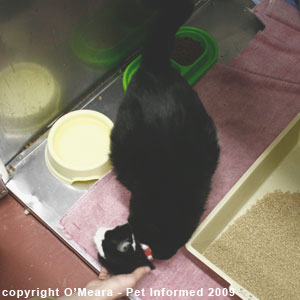 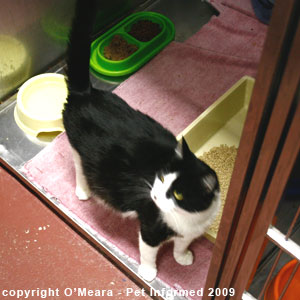 Cat pregnancy signs pictures 1 and 2: These are pictures of a heavily pregnant cat in the later stages of cat pregnancy (she has since gone on to have her litter). Her abdomen is very round and distended and hangs almost pendulously below her spine. 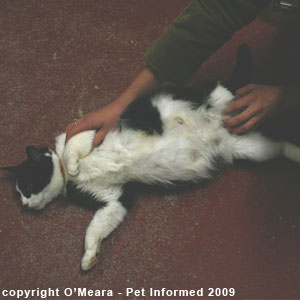 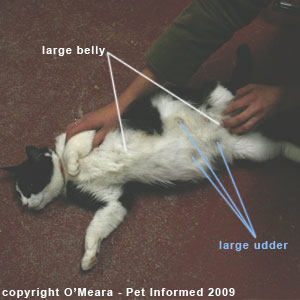 Feline pregnancy signs pictures 3 and 4: These are pictures of a heavily pregnant cat in the later stages of cat pregnancy (she has since gone on to have her litter). She is laying on her back and her swollen belly expands outwards around her. Her abdomen is very round and distended. Her udder (mammary gland chain) is now well developed with large, well-developed nipples and enlargement of the mammary blood vessels. No milk was yet being produced by this cat. 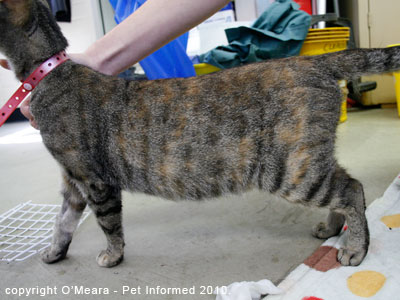 Cat pregnancy signs image 5: This is a picture of a cat in the middle stages of cat pregnancy (she is nowhere near as advanced as the black and white cat above). Her abdomen is just starting to drop down and become distended and her back is mildly bowed with the increasing weight of her pregnancy. 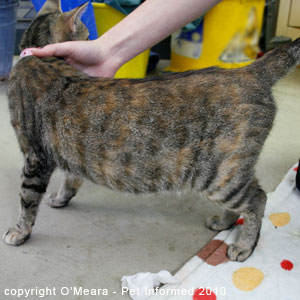 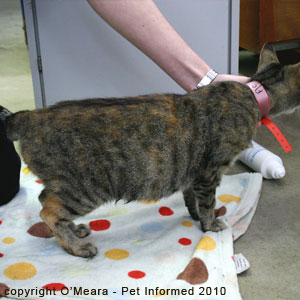 Cat pregnancy signs images 6 and 7: These are images of a cat in the middle stages of cat pregnancy (she is nowhere near as advanced in her pregnancy as the black and white cat above). Her abdomen is just starting to drop down and become distended and her back is mildly bowed with the increasing weight of her pregnancy. 1c) Weight gain or weight distribution changes seen during cat pregnancy. If fed properly (i.e. in a manner appropriate to their pregnant condition), pregnant cats will usually gain weight (weigh more on the scales) in the latter stages of their pregnancy as their fetal kittens grow in size and increase in mass. This overall increase in body-weight is the combined effect of the mother cat's own body-weight as well as the weight of the enlarged pregnant uterus, the growing kitten fetuses and the bulky placental fluids and membranes that surround each fetus. If pregnant female cats are not fed quite enough food or if the kittens are growing exceptionally rapidly or are large in number, such that their use of nutrient calories out-strips the amount of nutrients that the female cat can take in through diet alone, then a body-weight redistribution, rather than an overall weight increase, may be seen instead. In these cases, the female pregnant cat will sacrifice her ingested dietary nutrients and even her body reserves of fat and, in severe cases, muscle protein, redirecting them to the placenta so that the unborn kittens will be able to grow and thrive. This occurs at the expense of the mother cat and her own body-weight. The female cat will generally lose weight over the dorsal spine, ribcage and pelvic bones (the so-called "top-line"), becoming thin in these areas. The mother cat's skin may even appear thinner (almost see-through) as a result of the consumption (breakdown) of the subcutaneous fat stores located just beneath the skin (the fat will be utilised to support the kittens). The uterus, kittens and mammary glands will continue to grow because of all of the nutrients being diverted to them and, consequently, these regions of the female cat's body will continue to enlarge. The end result will be an overall shape change for the pregnant cat. The cat will appear thin and ribby-looking over much of the body (particularly over the dorsal hip-bones, ribs and spine) with a large, pendulous, swollen tummy and mammary glands. In these cats, the topline will appear thin and narrow, but the belly will be enormous and round (like a pear). 1d) An abdominal mass or fetal movement may be felt by the cat's owner. 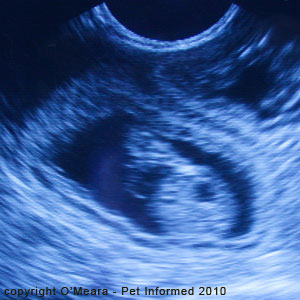 In the later stages of cat pregnancy (generally the last 1-2 weeks of feline pregnancy), the cat owner may be able to feel the fetal kittens if s/he very gently palpates and presses upon the walls of the cat's abdomen with his/her fingers. Fetal
kittens feel solid and firm and irregular in shape, but smooth in outline (like a weird, firm, smooth, knobby mass, which seems like
it should not be there) and will generally float or drift
away from you when touched (i.e. they are not fixed in position). Occasionally, a cat
owner may even be lucky enough to feel the pointy impression of an elbow or a knee
when gently running his/her hands across and into the animal's sides and belly.
Contact with this elbow or knee may even elicit an annoyed kick or twitch from the kitten
it belongs to - a sure sign that the cat is pregnant and that the kittens are alive.
In the later stages of cat pregnancy (generally the last 1-2 weeks of feline pregnancy), the cat owner may be able to feel the fetal kittens if s/he very gently palpates and presses upon the walls of the cat's abdomen with his/her fingers. Fetal
kittens feel solid and firm and irregular in shape, but smooth in outline (like a weird, firm, smooth, knobby mass, which seems like
it should not be there) and will generally float or drift
away from you when touched (i.e. they are not fixed in position). Occasionally, a cat
owner may even be lucky enough to feel the pointy impression of an elbow or a knee
when gently running his/her hands across and into the animal's sides and belly.
Contact with this elbow or knee may even elicit an annoyed kick or twitch from the kitten
it belongs to - a sure sign that the cat is pregnant and that the kittens are alive. In the late stages of cat pregnancy, the kittens will usually be quite mobile. Owners sitting with their hand resting on the belly of their pregnant cat may feel sudden twitches under the skin as the kittens roll and kick or the odd bump as a kitten rises up, bounces off their hand and disappears again. In cats with very thin fur, no contact with the pregnant cat may be needed in order for owners to be able to see the kittens moving about within the cat's abdomen. The cat's abdomen will appear to move about, with focal areas of the belly occasionally lifting out in domed or pointy shapes as the kitten's heads and legs press and push outwards. 1e) Mammary gland enlargement and mammary gland blood vessel dilation seen during feline pregnancy. In the final week/s of pregnancy, the pregnant cat's mammary glands enlarge and develop, becoming firm, large and obvious. The nipples on the cat's mammary glands also enlarge too, becoming pointed and protuberant. This greatly increased mammary gland (breast) development generally occurs after the abdominal distension characteristic of pregnancy has already become obvious (i.e. mammary gland enlargement is a later stage finding). Author's note: Subjectively, I have found that the blood vessels supplying the mammary glands (especially the caudal superficial epigastric arteries and veins) become engorged, enlarged and greater in size some time before the mammary gland tissues themselves become obviously increased in size. At the vet clinic, I have often "guessed" that a cat is pregnant even if no other cat pregnancy signs are yet obvious by observing the enlargement of the mammary gland blood vessels. Double-checking these cases with ultrasound has often discovered a mid-to-later term feline pregnancy. I doubt it is scientific and I very much doubt it can be proven - it's just something I've noticed quite commonly. Author's note: Please note that the enlarged, dilated mammary gland blood vessels are not only seen with pregnancy. Female cats who are in heat or who have very recently been in heat (i.e. post-heat cats) also seem to have more obvious mammary gland blood vessels. Again, just an observation.  
Cat pregnancy signs pictures 8 and 9: These are pictures of a heavily pregnant cat in the later stages of cat pregnancy (she has since gone on to have her litter). She is laying on her back and her swollen belly expands outwards around her. Her abdomen is very round and distended. Her udder (mammary gland chain) is now well developed with large, well-developed nipples and enlargement of the mammary blood vessels. No milk was yet being produced by this cat. 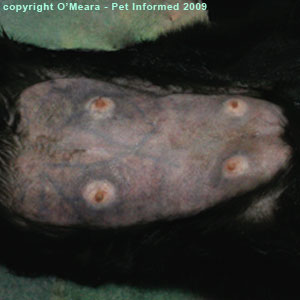 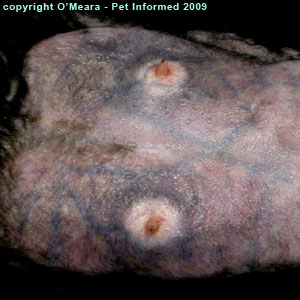
Feline pregnancy signs picture 10: This is an image of the enlarged udder of a pregnant cat (the cat's fur has been shaved from the belly for ease of visualisation). The mammary glands are massively enlarged, as are the blood vessels (blue lines criss-crossing the skin) supplying them. Feline pregnancy signs picture 11: This is a close up image of the enlarged udder of a pregnant cat. The blood vessels (dark blue-purple lines criss-crossing the skin) supplying the engorged mammary glands are very dilated and large. 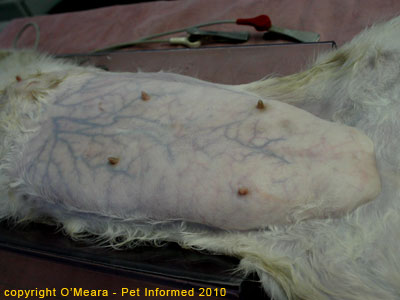 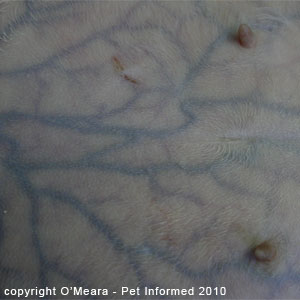
Cat pregnancy signs photo 12: This is an image of the massively-enlarged udder of a pregnant cat (the cat's fur has been shaved from the belly for ease of visualisation). The mammary glands take the form of a massively enlarged, raised slab of tissue (outlined in white in image 14, below) with numerous, interlacing blood vessels (the blue lines criss-crossing the skin) supplying them. Feline pregnancy signs picture 13: This is a close up image of the surface of the udder (mammary tissue skin) of the pregnant cat pictured in image 12. The blood vessels (dark blue-purple lines criss-crossing the skin) supplying the engorged mammary glands are very dilated and large with many branches. 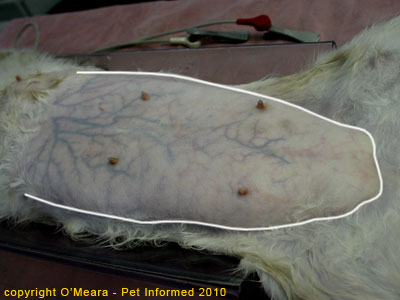 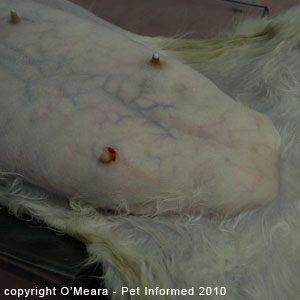
Feline pregnancy signs photo 14: This is an image of the massively-enlarged udder of a pregnant cat (the cat's fur has been shaved from the belly for ease of visualisation). The mammary glands take the form of a massively enlarged, raised slab of tissue (outlined in white) with numerous, interlacing blood vessels (the blue lines criss-crossing the skin) supplying them. Feline pregnancy signs picture 15: This is an image of the caudal aspect of the massively-enlarged udder of a pregnant cat, pictured in image 14. This image shows how well-defined the mammary gland tissue is from the rest of the abdominal wall. The enlarged mammary glands literally take the form of a massive, raised slab of pale, milk-filled glandular tissue. 1f) Signs of Pregnant Cats - Milk and colostrum production just prior to birth. At the very end of feline pregnancy, in the final days of gestation immediately before the birth (parturition) of the kittens, the already enlarged mammary glands start to produce milk for the soon-to-be born kittens to feed upon. The milk that is produced first by the mammary glands just prior to the arrival of the kittens is yellow in color and not completely opaque (i.e. it does not look like normal, white milk). This yellow milk is called colostrum (the "first milk") and it is packed full of antibodies from the mother (maternal antibodies), which are essential to helping the kittens to fight diseases prior to the maturation of their own immune systems. It is essential that each of the kittens does receive a good feed of colostrum within the first 24 hours (ideally the first twelve hours) after birth otherwise the kittens will be susceptible to infection from local bacteria and viruses in the mother's environment. Pet owners can check whether their pregnant cat is close to giving birth by gently expressing one of the teats and seeing if milk (usually yellow colostrum) appears. The cat owner should wash his hands thoroughly in detergent and rinse them well before squeezing the teat so that bacterial contamination of the teat is minimised (hands have lots of bacteria on them). The cat owner should only sample one or two teats at most (i.e. just enough to prove that milk is being made) and, even then, only squeeze the udder just enough to make a single drop of milk or colostrum bead from the tip of teat. Don't keep on repeatedly squeezing the teat so that drops of milk start dripping out because this is wasteful. The pregnant cat only makes a certain amount of colostrum and you don't want to be responsible for the cat losing her valuable colostrum because you kept on testing the nipple for milk! Author's note: If you squeeze the teats prior to birthing and only bright, white, opaque milk appears instead of colostrum, make a note of it. It is possible that this pregnant cat has not produced colostrum or that the colostrum made is poor in quantity or antibody quality. These kittens may well not receive enough of their maternal antibodies from this cat and they will, therefore, be more susceptible to infectious disease. The owners of such cats will have to be very vigilant about keeping their cat's nursery quarters very clean; dipping their kitten's freshly-cut umbilical cords in dilute betadine (to prevent umbilical cord infection or "navel-ill") and watching for any signs of illness, particularly respiratory illness (early antibiotic intervention may be required if such immune-starved kittens are to recover from mild bacterial infections that would have been minimally harmful in kittens that received their full quota of colostrum). 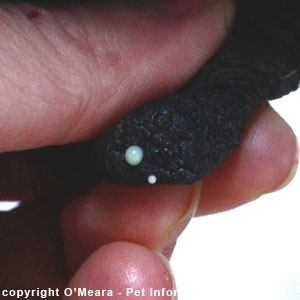
Signs of Pregnant Cats picture 16: This is a close up image of the udder of a pregnant dog who is shortly about to give birth. The dog's udder was large, sagging and pendulous with large, milk-filled nipples. When the mammary gland was expressed, milk beaded on the tips of the nipples. This particular mammary gland revealed a honey-like, watery, pale-yellow, straw-coloured milk called "colostrum" (the first milk). The colostrum appears a bit greenish (rather than yellow) in this image because colostrum is not fully opaque like true milk is and the black pigmentation of the nipple skin behind it is showing through the colostrum fluid, artificially darkening the colour. 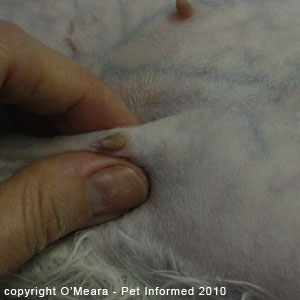 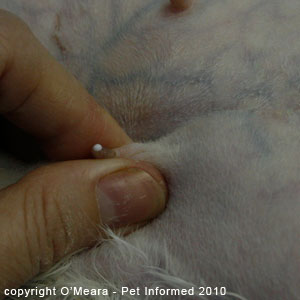 Feline pregnancy signs pictures 17 and 18: This is the mammary gland of a late pregnant cat. When the mammary gland is expressed, white milk beads on the tip of the cat's nipple. 1g) Behavioral changes seen in the cat during feline pregnancy. When cats become pregnant, their body comes under the influence of large quantities of progesterone. Progesterone is a reproductive hormone that is made by the corpus lutea during early pregnancy (large, yellow, secretory nodules which form on the surface of the cat's ovaries following the ovulation of eggs from the ripe ovarian follicles) and by the fetal kitten placenta during late pregnancy. Progesterone's role is to make the uterine environment satisfactory for embryonic nutrition and implantation to occur (during the first 2-3 weeks of pregnancy) and to help with the maintenance of pregnancy throughout the entire cat gestation period. Progesterone suppresses uterine wall motility and thereby prevents the uterus from contracting and moving and inadvertently expelling or aborting the babies prior to term. Progesterone also has a behavior modifying effect on the female cat. It makes the cat relaxed and calm during pregnancy and owners often comment that their pregnant cats are less moody and more mellow and even-tempered with fewer displays of anxiety or aggression. Some cats may even appear more affectionate than normal. The animal will typically show no signs of feline heat behavior during pregnancy, although heat signs may occasionally be seen in pregnant cats just before the onset of birth (whelping or parturition), when, for a brief time, progesterone levels plummet and estrogen levels dominate (producing signs of heat behaviour). Another one of the feline pregnancy signs is an increase in appetite. Pregnant cats are eating for themselves and for their babies and so pet owners will normally notice that their pregnant pets are always hungry and begging for food. In the very last 1-2 days of feline pregnancy, just prior to the onset of birth, the pregnant cat will start to show nesting behaviours. Considered to be part of the first stage of feline labor, nesting is when the pregnant cat prepares a safe, warm, quiet, out-of-the-way place in which to have her kittens. Generally, female cats will just go off and find a warm, comfortable place to hide and give birth (e.g. a clothes closet, under a house, in a specially-designed cat nesting box, in a washing basket ...), but some cats will make a huge production of it, dragging items of clothing and even toys into the bed to make it even more perfect and comfortable. 2) Conditions that mimic and look like feline pregnancy signs. There are other conditions (both disease and non-disease conditions) that can produce symptoms and signs, which are similar to those seen in feline pregnancy. Some of these conditions produce abdominal enlargement and some of them produce mammary gland enlargement (breast enlargement) and even milk production! Conditions other than feline pregnancy that cause abdominal swelling and cat belly enlargement:
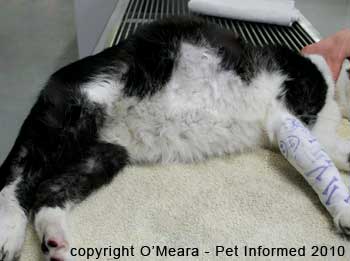
This is a picture of a cat with a very swollen abdomen (the cat's head is outside-of-image to the right). The belly was swollen because the cat's abdominal cavity was full of inflammatory fluid. The cat had FIP (Feline Infectious Peritonitis) and was not pregnant, despite the pregnant-looking appearance. Conditions other than feline pregnancy that cause mammary gland enlargement and sometimes milk production:
|